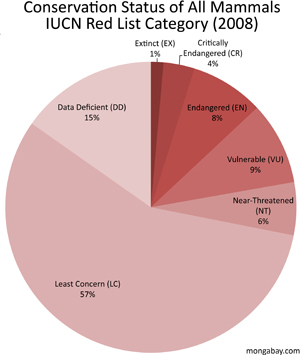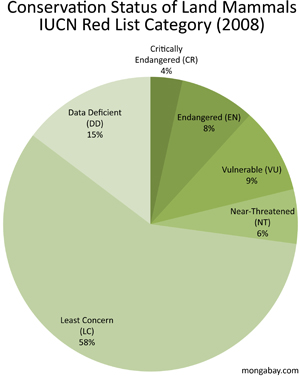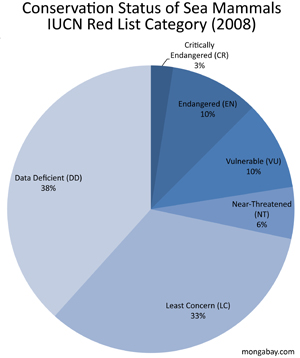One quarter to one third of mammals threatened with extinction
mongabay.com
October 6, 2008
|
|
One in four of the world’s land mammal species and one in three marine mammal species is threatened with extinction, according to an update of the IUCN Red List, the gold standard for the conservation status of global biodiversity.
The five-year assessment by more than 1700 experts in 130 countries compiled detailed information on taxonomy, distribution, habitats, population trends, and conservation status of, as well as threats to, the world’s 5,487 mammal species. The results show that 21 to 36 percent of mammals are at risk of extinction, while 76 mammals species are known to have gone extinct since 1500 and another two species have disappeared in the wild.
“Our results paint a bleak picture of the global status of mammals worldwide,” the authors write. “We estimate that one in four species is threatened with extinction and that the population of one in two is declining.”
   Click images to enlarge |
Mammals species are principally at risk on land from habitat loss (affecting 40 percent of species assessed) and over-havesting (affecting 17 percent). In the seas, pollution (affecting 60 percent) and accidental mortality (affecting 78 percent), often as bycatch, are the greatest dangers. While the nature and degree of threat vary regionally, threatened land mammals are concentrated in South and Southeast Asia where 79 percent of primates are at risk of extinction. Other areas where land mammals face particularly high risk include the tropical Andes in South America, the Cameroonian Highlands in West Africa, Albertine Rift in East Africa, and Western Ghats in India. Threatened marine species are concentrated in the North Atlantic, the North Pacific, and Southeast Asia. Large-bodied species are particularly at risk.
The assessment also revealed that while mammals are generally the best studied group of organisms, surprisingly little is known about many species and “new” species continue to be discovered at a high rate. Among sea mammals, IUCN lists 38 percent as “data deficient” meaning too little information is available for a species to determine its conservation status. For land mammals the figure is 15 percent. Meanwhile the number of recognized
species has increased by 19 percent since 1992, including 349 newly described species and 512 taxa that were elevated to species level through DNA analysis and other means. The bulk of these species were discovered in Madagascar and the Amazon, but the assessment says that greater effort in poorly studied regions like the Congo could yield still more species.
The authors note that while the outlook for mammals is dire, the assessment offers opportunities for improving conservation initiatives by identifying imperilled species and the risks they face.
“More than simply reporting on the depressing status of the world’s mammals, these Red List data can and should be used to inform strategies for addressing this crisis, for example to identify priority species and areas for conservation. Further, these data can be used to indicate trends in conservation status over time. Despite a general deterioration in the status of mammals, our data also show that species recoveries are possible through targeted conservation efforts,” the authors conclude.